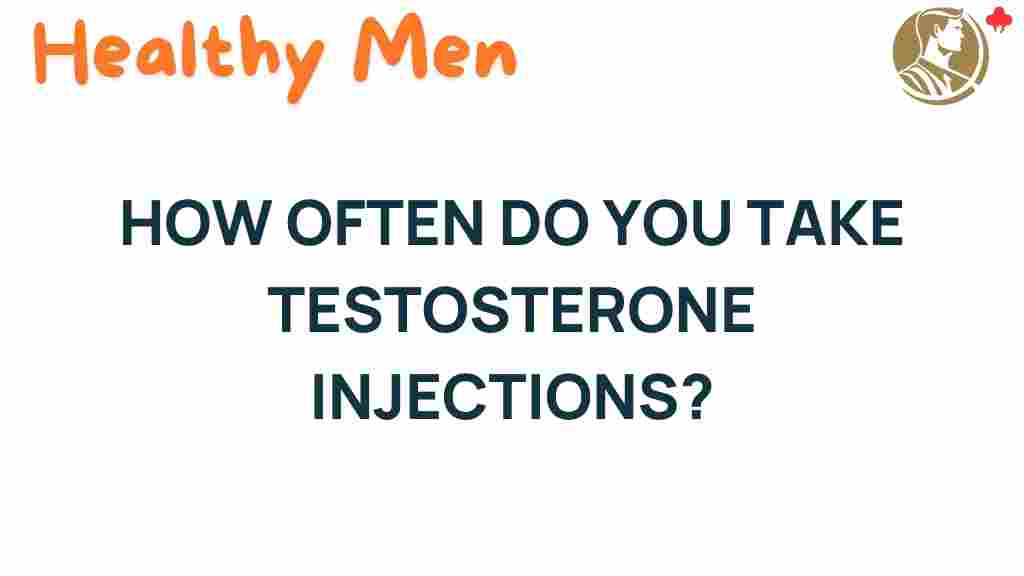Unlocking the Secrets: How Often Should You Take Testosterone Injections?
Testosterone injections have become a popular form of hormone therapy for men experiencing low testosterone levels. As awareness grows about men’s wellness and the significance of maintaining optimal hormone levels, many are left wondering about the appropriate frequency for testosterone injections. In this article, we will explore treatment guidelines, frequency recommendations, and important considerations regarding testosterone injections, ensuring you have the information needed to make informed decisions about your health.
Understanding Testosterone and Its Importance
Testosterone is a crucial hormone in the male body, playing a vital role in a variety of functions, including:
- Regulating libido
- Maintaining muscle mass
- Supporting bone density
- Contributing to mood stability
- Enhancing cognitive functions
When testosterone levels drop, which can occur due to age, medical conditions, or lifestyle factors, men may experience symptoms such as fatigue, depression, reduced libido, and decreased muscle strength. This is where testosterone injections come into play as a form of hormone therapy aimed at restoring healthy testosterone levels.
The Basics of Testosterone Injections
Testosterone injections are typically administered intramuscularly or subcutaneously, depending on the specific formulation and the patient’s preference. The injections can be prescribed in various forms, including:
- Testosterone enanthate
- Testosterone cypionate
- Testosterone undecanoate
The choice of formulation can affect how often you need to take testosterone injections, as different types have varying half-lives and absorption rates.
Frequency of Testosterone Injections
The frequency of testosterone injections largely depends on several factors, including:
- The specific testosterone formulation used
- Your individual hormone levels
- Your treatment goals
- Your body’s response to therapy
Common frequencies for testosterone injections are:
- Every 1 to 2 weeks for testosterone enanthate and testosterone cypionate
- Every 10 to 14 weeks for testosterone undecanoate
It’s essential to follow your healthcare provider’s recommendations regarding frequency, as they will tailor the treatment to your individual needs and monitor your health throughout the process.
Step-by-Step Process for Receiving Testosterone Injections
Here’s a step-by-step guide on how to properly manage your testosterone injections:
- Consult with a Healthcare Provider: Before starting therapy, schedule a consultation with a qualified healthcare provider or endocrinologist. They will evaluate your symptoms, order blood tests to check your testosterone levels, and determine if hormone therapy is appropriate for you.
- Receive a Diagnosis: If low testosterone levels are confirmed, discuss the potential benefits and risks of testosterone injections with your provider.
- Choose a Formulation: Based on your health and lifestyle, your provider will recommend a specific testosterone formulation that aligns with your needs.
- Schedule Your Injections: Depending on the formulation, set a schedule for your injections. Ensure you have a clear understanding of how often you will need to receive them.
- Monitor Your Response: After starting treatment, stay in close contact with your provider. Regularly scheduled blood tests will help monitor your testosterone levels and overall health.
- Adjust as Needed: Based on your response to therapy, your provider may adjust the dosage or frequency of injections to optimize your treatment.
Possible Side Effects of Testosterone Injections
While testosterone therapy can offer significant benefits, it’s crucial to be aware of potential side effects, including:
- Acne or oily skin
- Increased body hair growth
- Fluid retention
- Breast enlargement
- Sleep apnea
Discuss any side effects you experience with your healthcare provider, as they may need to adjust your treatment plan.
Troubleshooting Common Issues
Sometimes patients may face challenges during their testosterone therapy. Here are some common issues and troubleshooting tips:
- Inconsistent Energy Levels: If you experience fluctuations in energy, discuss your injection schedule with your provider. Adjusting the frequency or dosage may help stabilize your energy levels.
- Injection Site Reactions: If you notice pain, swelling, or redness at the injection site, ensure you are following proper injection techniques. If the issue persists, consult your healthcare provider.
- Emotional Changes: Some patients may experience mood swings or increased irritability. It’s important to communicate these changes with your provider, as they may suggest adjustments to your treatment.
Maintaining Healthy Testosterone Levels
In addition to testosterone injections, there are lifestyle changes you can implement to support healthy testosterone levels:
- Regular Exercise: Engaging in both aerobic and resistance training can boost testosterone production naturally.
- Healthy Diet: A balanced diet rich in healthy fats, proteins, and carbohydrates can support hormone production.
- Quality Sleep: Aim for 7-9 hours of quality sleep each night to help regulate hormone levels.
- Stress Management: Practice stress-reducing techniques like meditation, yoga, or deep breathing exercises.
Medical Advice and Follow-Up
Always follow your healthcare provider’s medical advice regarding testosterone therapy. Regular follow-ups are essential to:
- Monitor testosterone levels and adjust treatment as needed
- Screen for potential side effects and health issues
- Evaluate the overall effectiveness of the treatment
For personalized medical advice, consider consulting with a specialist in endocrinology. They can provide insights tailored specifically for your health needs. You can find more information on hormone therapy here.
Conclusion
Understanding how often to take testosterone injections is crucial for men undergoing hormone therapy. The frequency of injections can vary significantly based on individual health needs and the specific formulation used. Regular communication with your healthcare provider is key to optimizing treatment and managing any potential side effects.
By combining testosterone injections with healthy lifestyle choices, you can enhance your overall well-being and maintain optimal testosterone levels. Always prioritize medical advice and follow your provider’s recommendations to achieve the best outcomes in your journey toward men’s wellness.
For more detailed information on men’s hormone health, check out this resource.
This article is in the category Conditions and created by healthymen Team
